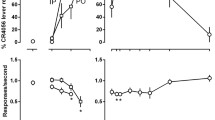Abstract
The role of 5-HT1A autoreceptors in the discriminative stimulus properties of 8-OH-DPAT (0.1 mg/kg, SC) in rats, was investigated. Drug lever appropriate responding to 8-OH-DPAT (0.1 mg/kg, SC) and ipsapirone (3 mg/kg, SC) was measured before and after treatment with para-chlorophenylalanine (pCPA) at a dose (150 mg/kg IP, −3 and −2 days) which causes severe depletion of brain 5-HT stores. The recognition of the drug stimulus was not significantly altered by pCPA. These results indicate that activation of 5-HT1A autoreceptors is of minimal importance to the 8-OH-DPAT cue.
Similar content being viewed by others
References
Colpaert FC, Niemegeers CJE, Janssen PAJ (1975) The narcotic cue: evidence for the specificity of the stimulus properties of narcotic drugs. Arch Int Pharmacodyn Ther 218:268–276
Cunningham KA, Callahan PM, Appel JB (1987) Discriminative stimulus properties of 8-hydroxy-2-(di-n-propyl-amino)tetralin (8-OH-DPAT): implications for understanding the actions of novel anxiolytics. Eur J Pharmacol 138:29–36
Danysz W, Fowler CJ, Ahlenius S, Archer T (1987) “Selective” lesions of brain neurotransmitters can be misleading. TIPS 8:45–46
Dompert WU, Glaser T, Traber J (1985)3H-TVX Q 7821: identification of 5-HT1 binding sites as a target for novel putative anxiolytic. Naunyn-Schmiedeberg's Arch Pharmacol 328:467–470
Dourish CT, Hutson PH, Curzon G (1986a) The novel putative anxiolytics 8-OH-DPAT, buspirone, and TVX Q 7821 are agonists at 5-HT1A autoreceptors in the raphe nuclei. TIPS 7:212–214
Dourish CT, Hutson PH, Curzon G (1986b) Para-chlorophenylalanine prevents feeding induced by the serotonin agonist 8-hydroxy-2-(di-n-propylamino)tetralin (8-OH-DPAT). Psychopharmacology 89:467–471
Extance K, Goudie AJ (1981) Inter-animal olfactory cues in operant drug discrimination procedures in rats. Psychopharmacology 73:363–371
Fozard JR, Mir AK, Middlemiss DN (1987) The cardiovascular response to 8-hydroxy-2-(di-n-propylamino)tetralin (8-OH-DPAT) in the rat: site of action and pharmacological analysis. J Cardiovasc Pharmacol 9:328–347
Fuller RW, Snoddy HD (1980) Effects of serotonin-releasing drugs on serum corticosterone concentration in rats. Neuroendocrinology 31:96–100
Glaser T (1988) Ipsapirone, a potent and selective 5-HT1A receptor ligand with anxiolytic and antidepressant properties. Drugs of the Future 13:429–439
Glennon RA (1986) Discriminative stimulus properties of the 5-HT1A agonist 8-hydroxy-2-(di-n-propylamino)tetralin (8-OH-DPAT). Pharmacol Biochem Behav 25:135–139
Glowinski J, Iversen LL (1966) Regional studies of catecholamines in rat brain. J Neurochem 13:655–669
Goodwin GM, De Souza RJ, Green AR (1986) The effects of a 5-HT1 receptor ligand isapirone (TVX Q 7821) on 5-HT synthesis and the behavioural effects of 5-HT agonists in mice and rats. Psychopharmacology 89:382–387
Green AR, Goodwin GM (1987) The pharmacology of the hypothermic response of rodents to 8-OH-DPAT administration and the effects of psychotropic drug administration on this response. In: Dourish CT, Ahlenius S, Hutson PH (eds) Brain 5-HT1A receptors. Ellis Horwood, Chichester, pp 161–176
Hjorth S, Magnusson T (1988) The 5-HT1A receptor agonist, 8-OH-DPAT, preferentially activates cell body 5-HT autoreceptors in rat brain in vivo. Naunyn-Schmiedeberg's Pharmacol 338:463–471
Hjorth S, Carlsson A, Lindberg P, Sanchez D, Wikstrom H, Arvidson L-E, Hacksel U, Nilson JLG (1982) 8-Hydroxy-2-(di-n-propylamino)tetralin, 8-OH-DPAT, a potent and selective simplified ergot congener with central 5-HT-receptor stimulating activity. J Neural Transm 55:169–188
Hutson PH, Donohue TP, Curzon G (1987) Neurochemical and behavioural evidence for an agonistic action of 1-[2-(4-aminophenyl)ethyl]-4-(3-trifluoromethylphenyl)piperazine (LY 165163) at central 5-HT receptors. Eur J Pharmacol 138:215–223
Hutson PH, Dourish CT, Curzon G (1988) Evidence that the hyperphagic response to 8-OH-DPAT is mediated by 5-HT1A receptors. Eur J Pharmacol 150:361–366
Kennett GA, Marcou M, Dourish CT, Curzon G (1987) Single administration of 5-HT1A agonist decreases 5-HT1A presynaptic, but not postsynaptic receptor-mediated responses: relationship to antidepressant-like action. Eur J Pharmacol 138:53–60
Middlemiss DN, Fozard JR (1983) 8-Hydroxy-2-(di-n-propylamino) tetralin discriminates between subtypes of the 5-HT1 recognition site. Eur J Pharmacol 90:151–153
Schoeffter P, Hoyer D (1988) Centrally acting hypotensive agents with affinity for 5-HT1A binding sites inhibit forskolin-stimulated adenylate cyclase activity in calf hippocampus. Br J Pharmacol 95:975–985
Siegel S (1956) Nonparametric statistics for the behavioural sciences. McGraw-Hill, New York, London
Smith LM, Peroutka SJ (1986) Differential effects of 5-hydroxytryptamine1A selective drugs on the 5-HT behavioural syndrom. Pharmacol Biochem Behav 24:1513–1519
Sprouse JS, Aghajanian GK (1987) Responses of hippocampal cells to putative serotonin 5-HT1A and 5-HT1B agonists: a comparative study with dorsal raphe neurons. Neuropharmacology 27:707–715
Tricklebank MD, Forler C, Fozard JR (1984) The involvement of subtypes of the 5-HT1 receptor and of catecholaminergic systems in the behavioural response to 8-hydroxy-2-(di-n-propylamino)tetralin in the rat. Eur J Pharmacol 106:271–282
Tricklebank MD, Neill J, Kidd EJ, Fozard JR (1987) Mediation of the discriminative stimulus properties of 8-hydroxy-2-(di-n-propyl-amino)tetralin (8-OH-DPAT) by the putative 5-HT1A receptor. Eur J Pharmacol 133:47–56
Van Delft AML, Kaplanski J, Smelik PG (1973) Circadian periodicity of pituitary-adrenal function afterp-chlorophenylalanine administration in the rat. J Endocrinol 59:465–474
Winter JC (1988) Generalization of the discriminative stimulus properties of 8-hydroxy-2-(di-n-propylamino)tetralin (8-OH-DPAT) and ipsapirone to yohimbine. Pharmacol Biochem Behav 29:193–195
Author information
Authors and Affiliations
Rights and permissions
About this article
Cite this article
Kalkman, H.O. Discriminative stimulus properties of 8-OH-DPAT in rats are not altered by pretreatment with para-chlorophenylalanine. Psychopharmacology 101, 39–42 (1990). https://doi.org/10.1007/BF02253715
Received:
Revised:
Issue Date:
DOI: https://doi.org/10.1007/BF02253715




